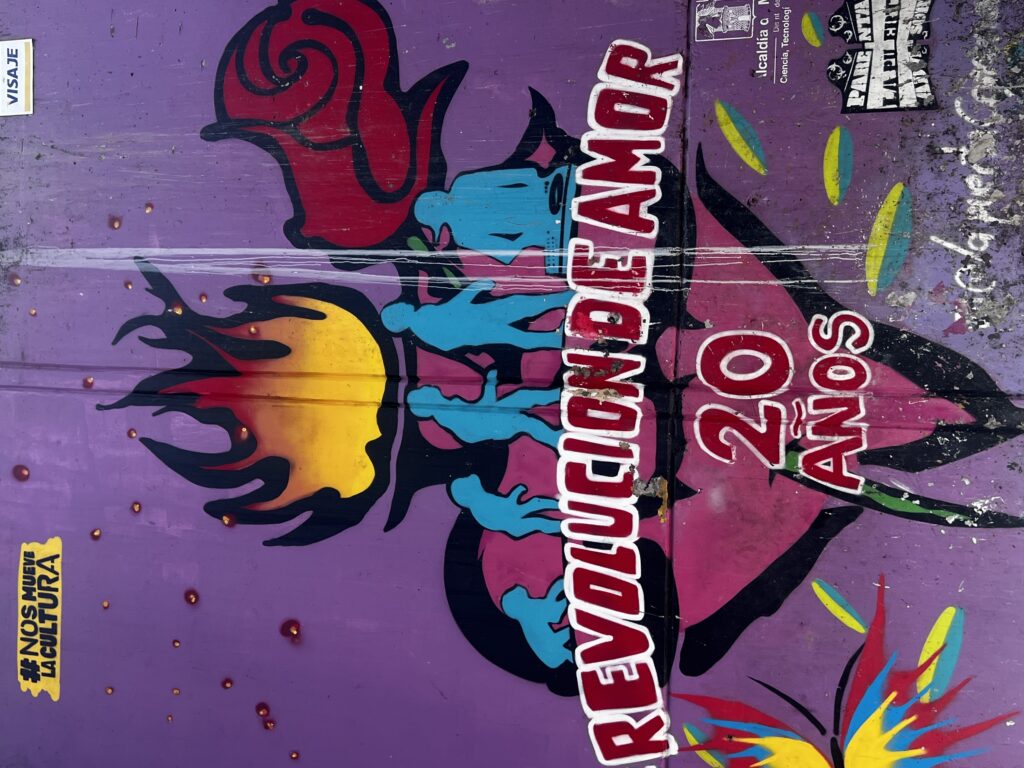By Ximena Ramírez Villanueva
Rediscovering Comuna 13 Through New Perspectives
During the last two weeks of my internship with Avocats Sans Frontières, I returned to Comuna 13 in Medellín, a place I had first visited two years earlier during my first solo trip to Colombia. This neighbourhood, once synonymous with violence and unrest, has experienced a profound transformation in recent years. Although I had visited Comuna 13 before, this time my perspective was shaped by the insights and experiences I gained through my work on the GENPAZ and FINTRATA projects—both of which focus on advancing transitional justice and addressing complex human rights issues in Colombia. I came to understand more deeply the significance of this place within the broader context of Colombia’s armed conflict and the ongoing process of reconciliation. Comuna 13’s story is one of remarkable resistance. Throughout the years of Colombia’s armed conflict, this neighbourhood was battleground for control among various armed groups, including paramilitaries, guerrillas, and drug cartels. The people of Comuna 13 lived through unimaginable hardships, yet they refused to let violence define their community. Through grassroots organizing, artistic expression, and sheer determination, the residents began to reclaim their neighbourhood. Today, Comuna 13 is known for its striking street art, bustling escalators, and the palpable energy of a community that has fought to rebuild itself. As I walked through the colourful streets, now filled with tourists taking photos and enjoying the lively atmosphere, I couldn’t help but feel a sense of dissonance. The transformation of Comuna 13 is undoubtedly a testament to the power of community and the possibility of change, but the influx of tourists often seems to overlook the painful history that made this transformation necessary. The joy and freedom that visitors experience in Comuna 13 today are built on the back of years of struggle and suffering — a fact that is too easily forgotten in the pursuit of a perfect Instagram shot or a cheap thrill.

Transitional Justice and Community Resilience in Comuna 13
The work I did on the GENPAZ project, alongside my involvement in the FINTRATA project, further deepened my understanding of the complexities facing Colombia. As part of a team dedicated to transitional justice, I worked on efforts to address the legacies of Colombia’s armed conflict, focusing on reparations, truth-telling, and accountability for serious crimes through the Special Jurisdiction for Peace. At the same time, the FINTRATA project involved investigations related to human trafficking, offering a broader perspective on the ongoing challenges related to justice and human rights in the country. These projects highlighted how deeply intertwined transitional justice is with the lived experiences of communities like those in Comuna 13. In this neighbourhood, I saw firsthand how the principles of justice, accountability, and resistance are not just abstract ideas but are crucial to the process of healing and reclaiming identity. The transformation of Comuna 13 from a place marked by violence to a thriving community is a powerful example of what can happen when communities take ownership of their narratives and refuse to be defined by their past traumas. However, this transformation also places a responsibility on those of us who engage with these spaces — whether as tourists, activists, or members of civil society.The colourful street art, the music, and the sense of hope that now defines Comuna 13 are the outcomes of a long and challenging process of healing and resistance. It is essential to honour this history by approaching it with the respect it deserves, recognizing that the determination of these communities is not a spectacle, but a profound statement of human endurance and integrity.

Reflections on a Transformative Internship Experience
As my internship draws to a close, I find myself reflecting on the profound impact this experience has had on both my personal and professional development. The work I engaged in through the GENPAZ and FINTRATA projects provided invaluable insights into the complexities of transitional justice and human rights, particularly in a country like Colombia, where the scars of conflict are still very much visible. Witnessing the transformation of Comuna 13 and learning about the broader implications of our work has deepened my appreciation for the determination and strength of the Colombian people. Their ability to overcome adversity and reclaim their narratives is not just inspiring — it is a testament to the enduring power of community and the critical role of justice in the healing process. This internship was my first foray into international human rights, and it has unequivocally confirmed my commitment to this field. The intellectual and emotional challenges I faced were significant, but they were matched by the deep sense of purpose and fulfillment I found in contributing to efforts that have real, tangible impacts on people’s lives. The lessons I’ve learned from the communities of Comuna 13, and from the broader work on transitional justice, have reinforced my dedication to pursuing a career where I can continue to advocate for justice, accountability, and human dignity. As I look ahead, I carry with me not only the knowledge and skills I’ve gained but also a renewed commitment to making meaningful contributions to the field of human rights, guided by the principles of resilience and resistance that I witnessed so powerfully during my time in Colombia.
